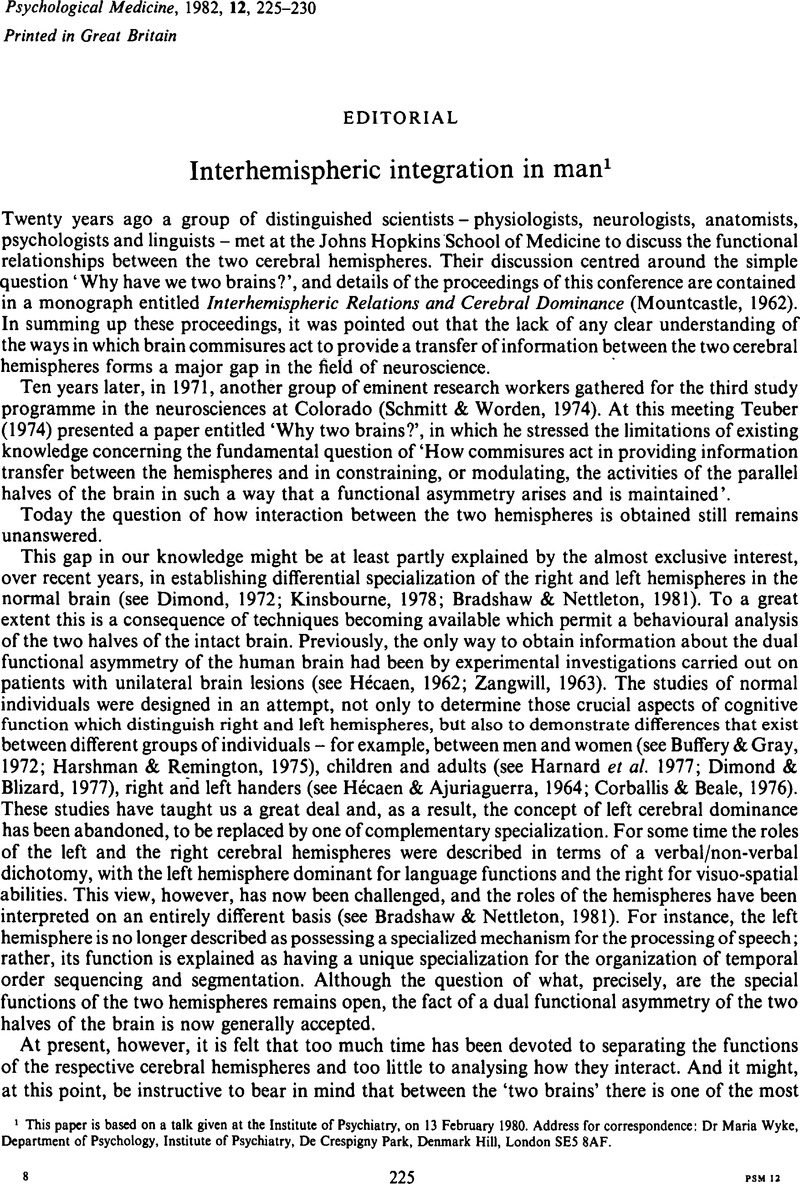No CrossRef data available.
Article contents
Interhemispheric integration in man1
Published online by Cambridge University Press: 09 July 2009
Abstract
An abstract is not available for this content so a preview has been provided. As you have access to this content, a full PDF is available via the ‘Save PDF’ action button.

- Type
- Editorial
- Information
- Copyright
- Copyright © Cambridge University Press 1982
References
REFERENCES
Abercrombie, M. L., Lindon, R. L. & Tyson, M. C. (1964). Associated movements in normal and physically handicapped children. Developmental Medicine and Child Neurology 6, 573–580.CrossRefGoogle ScholarPubMed
Basso, A., Bisiach, E. & Capitani, E. (1977). Decision in ambiguity: hemispheric dominance or interaction? Cortex 13, 96–99.CrossRefGoogle ScholarPubMed
Békésy, G. von (1967). Sensory Inhibition. Princeton University Press: Princeton, N.J.Google Scholar
Bradshaw, J. L. & Nettleton, N. C. (1981). The nature of hemisphere specialization in man. Behavioural and Brain Sciences 4, 51–91.CrossRefGoogle Scholar
Broadbent, D. E. (1974). Division of function and integration of behaviour. In The Neurosciences Third Study Program (ed. Schmitt, F. O. and Worden, F. G.), pp. 31–41. MIT Press: Cambridge, Mass.Google Scholar
Broadbcnt, D. E. & Gregory, M. (1965). On the interaction of S-R compatibility with other variables affecting reaction time. British Journal of Psychology 56, 61–67.CrossRefGoogle Scholar
Buffery, A. W. H. & Gray, J. A. (1972). Sex differences in the development of perceptual and linguistic skills. In Gender Differences: Their Ontogeny and Significance (ed. Ounsted, C. and Taylor, D. C.), pp. 123–157. Churchill: London.Google Scholar
Butler, S. R. & Norrsell, U. (1968). Vocalisation possibly initiated by the minor hemisphere. Nature 220, 793–794.CrossRefGoogle ScholarPubMed
Cernacek, J. (1961). Contralateral motor irradiation – cerebral dominance. Archives of Neurology and Psychiatry 4, 165–172.CrossRefGoogle ScholarPubMed
Corballis, M. C. & Beale, I. L. (1976). The Psychology of Left and Right. Lawrence Erlbaum: Hillsdale, N.J.Google Scholar
Dimond, S. & Beaumont, G. (1972). Processing in perceptual integration between and within the cerebral hemispheres. British Journal of Psychology 63, 509–514.CrossRefGoogle ScholarPubMed
Dimond, S. J. & Blizard, D. A. (1977). Evolution and Lateralisation of the Brain. New York Academy of Sciences: New York.Google ScholarPubMed
Fog, E. & Fog, M. (1963). Cerebral inhibition examined by associated movements. In Minimal Cerebral Dysfunction (ed. MacKeith, R. and Bax, M.), pp. 52–57. Little Club Clinics in Developmental Medicine, No. 10. Heinemann: London.Google Scholar
Gazzaniga, M. S. & Hillyard, S. A. (1971). Language and speech capacity of the right hemisphere. Neuropsychologia 9, 273–280.CrossRefGoogle ScholarPubMed
Goff, W. R., Rosner, B. S. & Allison, T. (1962). Distribution of cerebral somatosensory evoked responses in normal man. Electroencephalography and Clinical Neurophysiology 14, 697–713.CrossRefGoogle Scholar
Harnard, S., Doty, R. W., Goldstein, L., Jaynes, J. & Krauthamer, G. (eds.) (1977). Lateralizalion in the Nervous System. Academic Press: New York.Google Scholar
Harshman, R. A. & Remington, R. (1975). Sex, language and the brain: 2. Adult sex differences in lateralization. Mimeographed.Google Scholar
Heap, M. & Wyke, M. (1972). Learning of a unimanual skill in patients with brain lesions. Cortex 8, 1–18.CrossRefGoogle ScholarPubMed
Hécaen, H. (1962). Clinical symptomatology in right and left hemisphere lesions. In Interhemispheric Relations and Cerebral Dominance (ed. Mountcastle, V. B.), pp. 215–243. Johns Hopkins University Press: Baltimore.Google Scholar
Hécaen, H. & Ajuriaguerra, J. de (1964). Left-handedness, Manual Superiority and Cerebral Dominance. Grune & Stratton: New York.Google Scholar
Hopf, H. C., Schlegel, H. J. & Lowitzsch, K. (1974). Irradiation of voluntary activity to the contralateral site in movements of normal subjects and patients with central motor disturbances. European Neurology 12, 142–147.CrossRefGoogle Scholar
Kinsbourne, M. (1971). The minor cerebral hemisphere. Archives of Neurology 25, 302–306.CrossRefGoogle ScholarPubMed
Kinsbourne, M. (ed.) (1978). Asymmetrical Function of the Brain. Cambridge University Press: Cambridge.Google Scholar
Levy, J., Nebes, R. D. & Sperry, R. W. (1971). Expressive language in the surgically separated minor hemisphere. Cortex 7, 49–58.CrossRefGoogle ScholarPubMed
Milner, B. (1971). Interhemispheric differences and psychological process. British Medical Bulletin 27, 272–277.CrossRefGoogle Scholar
Mountcastle, V. B. (ed.) (1962). Interhemispheric Relations and Cerebral Dominance. Johns Hopkins University Press: Baltimore.Google Scholar
Patton, H. D., Towe, A. L. & Kennedy, T. T. (1962). Activation of pyramidal tract neurons by ipsilateral cutaneous stimuli. Journal of Neurophysiology 25, 501–514.CrossRefGoogle ScholarPubMed
Rosenzweig, M. R. (1951). Representation of the two ears at the auditory cortex. American Journal of Physiology 67, 147–158.CrossRefGoogle Scholar
Schmitt, F. O. & Worden, F. G. (eds.) (1974). The Neurosciences Third Study Program. MIT Press: Cambridge, Mass.Google Scholar
Schott, G. D. & Wyke, M. A. (1977). Obligatory bimanual associated movements. Journal of the Neurological Sciences 33, 301–312.CrossRefGoogle ScholarPubMed
Schott, G. D. & Wyke, M. A. (1981). Congenital mirror movements. Journal of Neurology, Neurosurgery and Psychiatry 44, 586–599.CrossRefGoogle ScholarPubMed
Sperry, R. W. (1962). Some general aspects of interhemispheric integration. In Interhemispheric Relations and Cerebral Dominance (ed. Mountcastle, V. B.), pp. 5–19. Johns Hopkins University Press: Baltimore.Google Scholar
Terzulo, C. A. & Adey, W. R. (1960). Sensorimotor activities. In Handbook of Physiology, Section I (Neurophysiology). vol. 2 (ed. Field, J., Magoun, H. W. and Hall, V. Z.), pp. 797–835. American Physiological Society: Washington, D.C.Google Scholar
Teuber, H. L. (1974). Why two brains? In The Neurosciences Third Study Program (ed. Schmitt, F. O. and Worden, F. G.), pp. 71–74. MIT Press: Cambridge, Mass.Google Scholar
Wyke, M. (1969). Influence of direction in the rapidity of bilateral arm movements. Neuropsychologia 7, 189–194.CrossRefGoogle Scholar
Zangwill, O. L. (1963). The cerebral localisation of psychological function. The Advancement of Science XX, 1963–1964.Google Scholar


